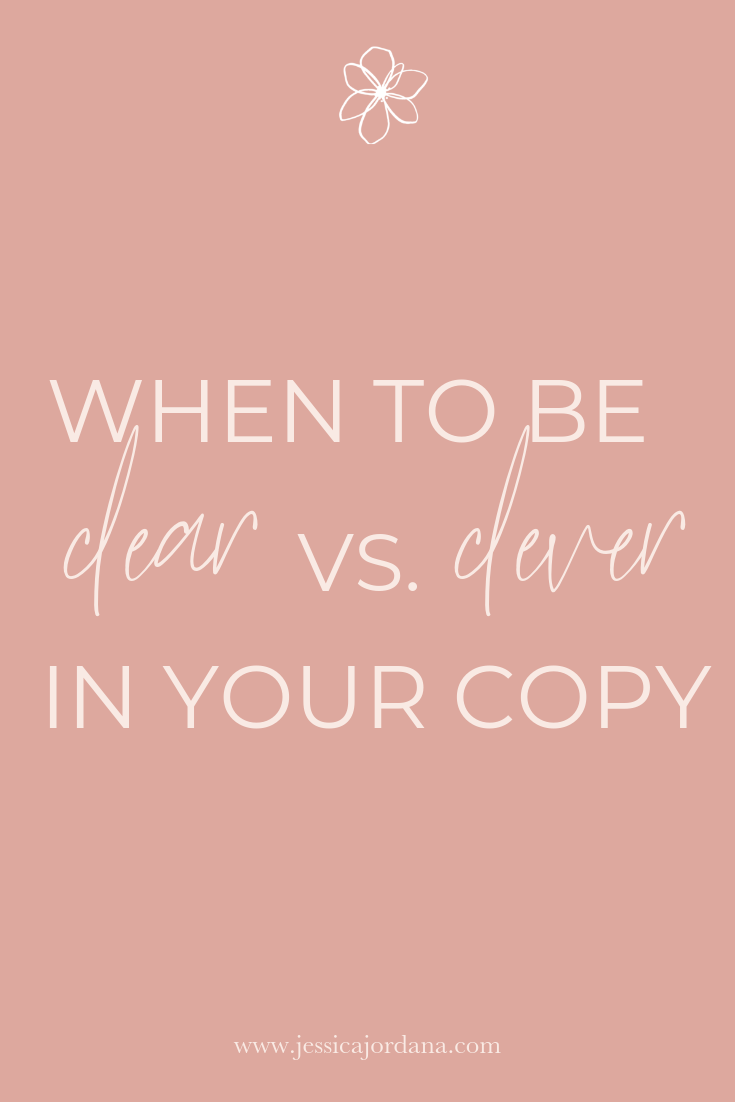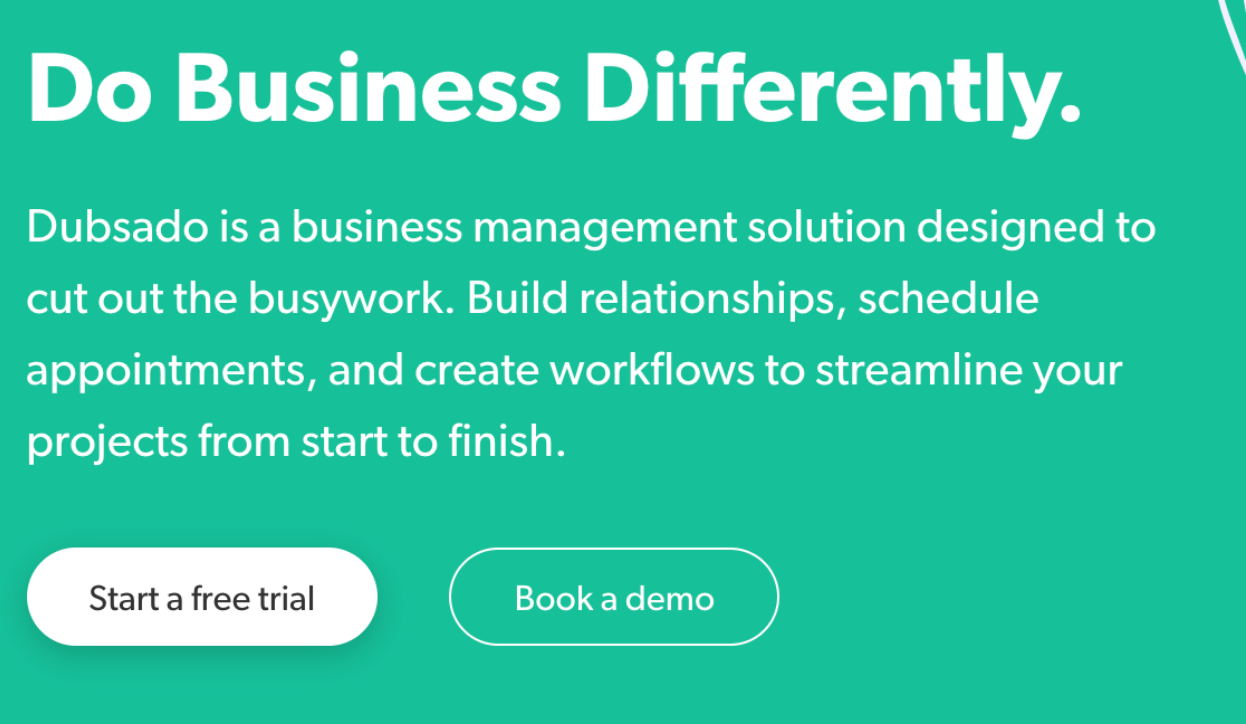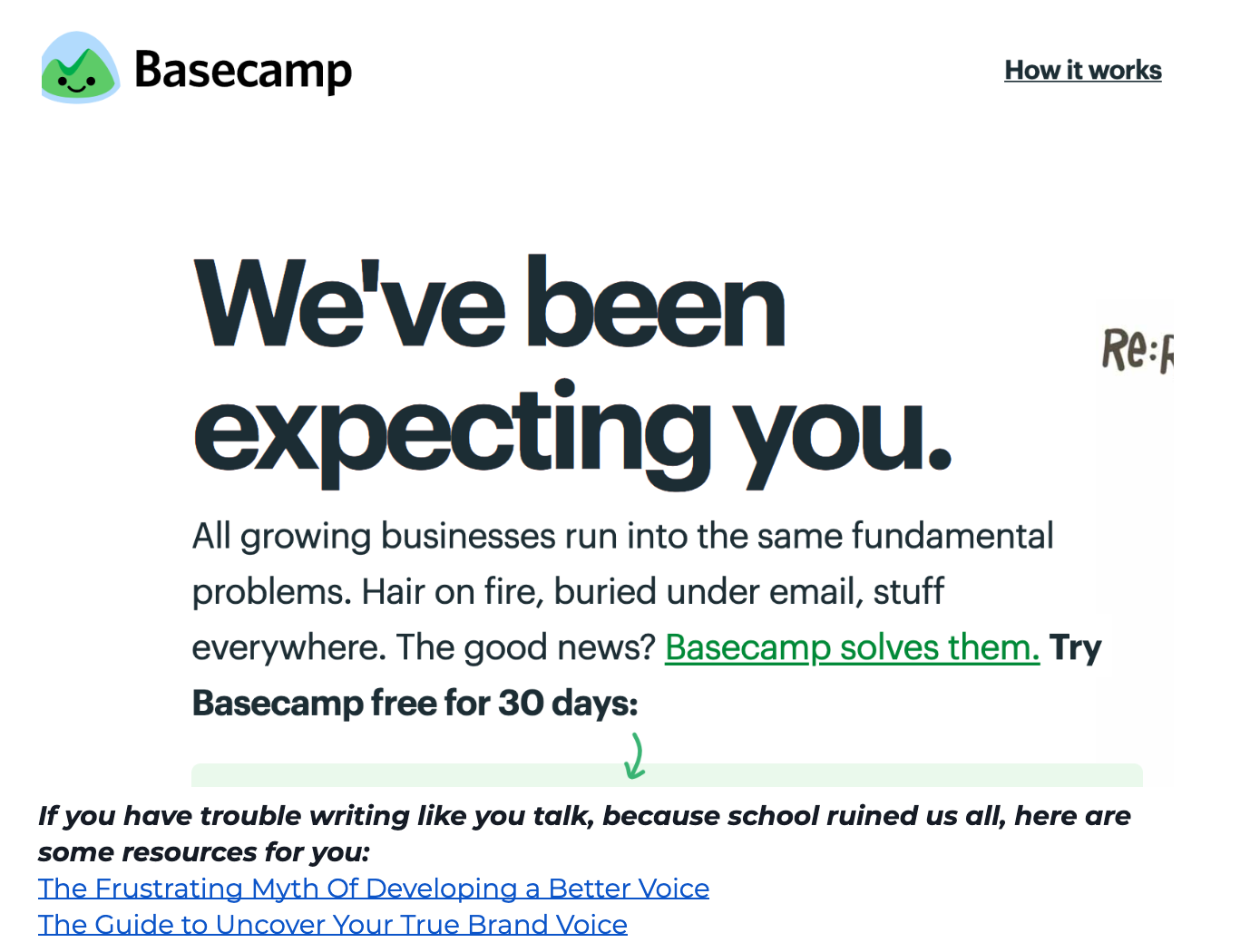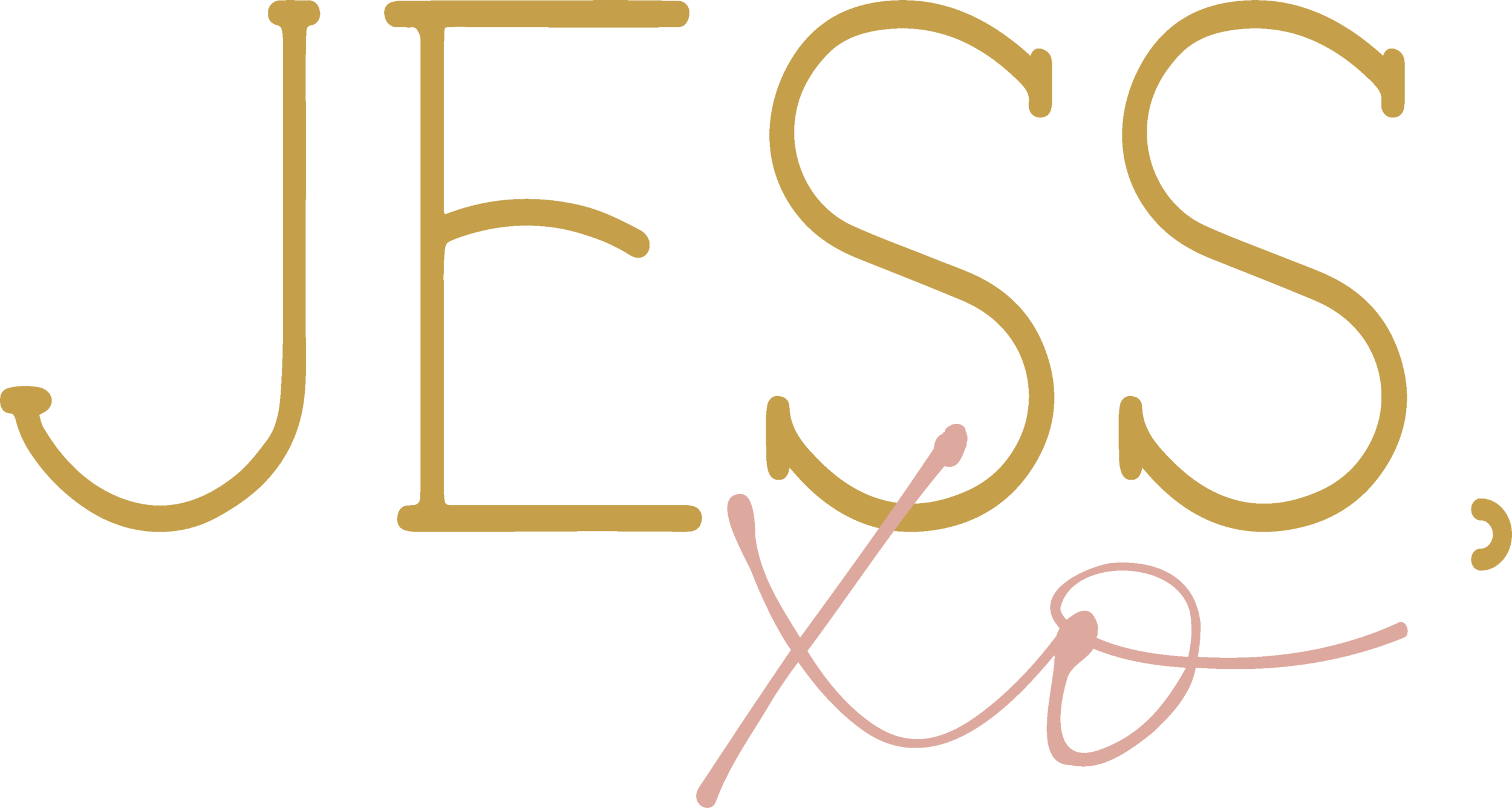When to be Clear vs. Clever in your Copy
August 14, 2019

“Um, you’re a little (okay A LOT) extra, Mrs. Paxson.”
I used to hear it all the time. In the classroom, I did my best to be different, to be animated, to be completely unexpected for my students–BUT, I employed this tactic at a very specific and strategic point of the school year.
The first week of school.
The first week of school was my chance to pique the students’ attention, so that they would at least be interested enough to come to class and give me a chance (something that was NOT a given with high school seniors in an English class).
After that first week of school, I certainly kept up the full-of-personality and “extra,” but we also got down to business a whole lot, too.
My students got to know me as that crazy lady who wears leopard pants and should probably be a kindergarten teacher.
But they also got to know me as the one who expected a lot and would help you get there.
This balance is a tricky one to strike, and I hear creative business owners struggling through it on the daily.
-
You want personality-filled copy, but you also want people to take you seriously.
-
You know you’re not writing like you talk, but how you talk seems too simple. Is that going to position you as an expert?
-
You’re concerned about coming off as unprofessional. You see other people doing the dang thing of being themselves in their business, but you’re just not sure what pieces of “yourself” belong in your message.
I get it.
There’s an art to crafting a message that’s both relatable and clear.
You need a message that pulls people in with a little bit of intrigue, but then delivers a result quickly to keep them around.
In this blog post, I’m addressing the question that so many of you have:
“How do I know when my words need to be clear, or when they can be clever? Is there such a thing as too much personality when it comes to copy?”
Short answer: The key isn’t how much personality, but where you put it.
WHEN TO BE CLEAR
Disclaimer:
Repeat after me, “Clear copy does not mean BORING copy.” Joanna Wiebe from Copyhackers always says, “It’s not true that people in our day and age won’t read long copy. It IS true that people in our day and age won’t read long and BORING copy.” Clear copy can be defined as words that people don’t have to work hard to interpret and take action from.
Here’s another way to think about it. In the book Made to Stick by Dan and Chip Heath, they explain:
“Be simple. Not simple in terms of “dumbing down” or “sound bites.” You don’t have to speak in monosyllables to be simple. What we mean by “simple” is finding the core of the idea.
A designer knows he has achieved perfection not when there is nothing left to add, but when there is nothing left to take away.”
So, if you are asking someone to download your free productivity guide, don’t add “unlock freedom now” as the button copy.
Instead, ask yourself: what is directly on the other side of taking action?
They get the free guide. That goes on the button.
Clear Copy? Tell it to ‘em straight.
Calls to Action: A clear description of what they’re clicking for, how they proceed, what’s next.
Value Propositions: What do you do and how do you do it? Be sure this statement of your value is free of jargon and free of language that needs too much interpretation. The goal is to get them to say, “yep, I need that,” not “oh, hmmm. That’s interesting.
Subheads: A subhead is what goes below a headline; subheads are often used to give a little more description or provide clarity for what was said above.
Dubsado’s subhead is a great example of providing clarity in a subhead. The main function of your header copy is to pique attention + keep them reading. The function of the subhead is to clarify the questions the header creates: okay, so… do business differently. That sounds nice, but what does that actually mean?
It’s important to drive your point home with clarity so people actually GET what it is you do and how they can help them. Only then will they say, “Oh, yep. I need that.”
Processes: When explaining the process of working with you, booking you as a service-provider, purchasing your product, keep it clear and benefit-focused. For example, if you have massive homework for your clients at the beginning of the process, you would want to explain it less as “massive homework” (which leads them to start thinking about their to-do list) and more as “a deep dive into your big vision for your business.” This benefit-focused shift will paint your process as something that will lead to results, joy, and unicorn rides rather than work, work, and more work that sounds scary.
Pop-Up Header: “Join my community” isn’t cutting it, guys. What will they get? A free download with 5 tips to {insert desired result here}? Weekly tips? About what? Be clear, because they are essentially PAYING you with their email address!
Location: This is key for SEO purposes as well as pure common sense. If you’re location-based, be clear about both your location, and possibly the locations you serve.
Photographers, please don’t only put “available worldwide.” Even if that’s true, it’s keeping people in your area from saying the fastest “yes” in the world because you’re exactly who they want and you are familiar with their location.
Contact: For the love of everything that’s good, PUT YOUR EMAIL ADDRESS IN YOUR FOOTER, at the very least.
Even better? Put it on your contact page right above your contact form. Yes, I know you have a contact form! And, I know you want people to contact you through that!
BUT, organizers, content curators, people who want to contact you for something amazing outside of the client work you provide don’t want to contact you through a form. It’s hard for them to track on their end. So, if you don’t have it on your site, you might have missed out on some opportunities! It’s a simple shift to implement now, so hop to!
Menus/Navigation: Get rid of the cutesy names in your navigation. Call your blog “blog,” and your contact page “contact.” I know there are titles that seem more creative, but people are working on autopilot and what they’re used to when it comes to navigation. Keeping it simple will lower your bounce rate and up your conversions because people will know where to go to get what they want
Booking/Buying: If you haven’t gone through your own website journey lately, make a little time to do it (and you can use the Dream Client Goggles Worksheet to help you out in the process) sooner rather than later. How many steps does a prospect need to take to get to the “book” or “buy” button. Is your messaging clear all the way throughout that journey? Does it tell them where to go, what to do next, etc.? Another easy fix!
WHEN TO BE CLEVER
Disclaimer:
Make sure your version of clever actually translates. It should never be a reference, a phrase, or a little tidbit that your audience just doesn’t get. BUT, your little sprinkles of voice are also the perfect opportunity to attract those absolutely perfect peeps into your circle of trust, and to repel those not-so-perfect people because they blamed Jinxy for the toilet flush.
(*This would be an example of a reference very few people get. I would only use this reference in my website copy if it was a NON-NEGOTIABLE that my dream person watched Meet the Parents, and appreciated crass humor. Here’s an image for some more clarity.)
Clever Copy? Keep it to these.
Headings: Use your heading space to pique attention and move your reader down to the next section. If they’re already on your About Page, try not to use “About Me” as a header, because that’s just wasting word real estate!
Crossheads + transition copy: A “crosshead” or piece of transition copy is a little splash of words on the page. Here’s an example from my friend, Jenna Kutcher:
Okay, fine, so we’re not friends yet. Girl can dream. See that “hey there” piece? That’s what I call a crosshead. She’s not wasting space by telling you what she’s going to write about, she’s giving you a glimpse into her voice and moving you down the page as it happens.
Microcopy: Microcopy can be a lot of different things, but one piece that often goes unnoticed? Autofill suggestions on your site’s forms.
Pro tip: The best autofill microcopy is funny–maybe even a little snarky.
Need an example? Trello uses funny email addresses of nerdy characters for their free signup forms. Paying attention to your microcopy shows that you are actually taking care of the little things in your business. I think it also goes a long way to show how much fun you can have with your business, too.
Newsletter preview copy: Preview copy is the little chunk of the body of an email you get to see in your inbox view. It pulls the first few lines of your email. This is an often unnoticed chance to grab attention. Try asking a question, saying something unexpected, or leaving an open loop that your reader will want to close.
About Page: If you’re stuck on how to make your about page more than a laundry list of accomplishments and credentials that may or may not matter, stay tuned for The About Page Promptlate when The Promptlate Shop launches in just a few weeks! People are RAVING about their about pages. Betcha didn’t even think that was possible, did ya?
GDPR info + website terms and conditions + return policies: I love when people play with the wording of these typically-dry policies. Be sure not to change anything that is legally necessary, but have fun with it!
For example, the terms and conditions required on a website automatically comes with an “I accept” phrase on the button. I’ve seen people change that to “cool, dude” or “got it, thanks!” Especially since people are highly familiar with the terms and conditions button, it shows a little flare if it’s a bit different.
For anything else not listed here, ask yourself this question: How aware is your visitor of your product or service?
As a copywriter, I have to break down the meaning of “copy” into “words,” in a lot of my messaging, because not every one of my visitors understands the concept quite yet.
Apple can go super creative and really high-level with their product copy because the level of awareness of their audience is very high. The Apple audience are die-hards, and they want to know all the jargon, the ins and outs, etc.
Again, to use Who Gives a Crap as an example (because they’re my FAVORITE), they can be super cheeky (no pun intended) with their copy because:
-
Everyone knows what toilet paper is.
-
Bathroom humor translates across social spheres.
-
They’re job is to show you how a toilet paper company can be different, and worth looking into.
(I gave some concrete examples of this company’s copy in this blog post from a couple weeks ago.)
So, ask yourself, how aware is your audience of what you do? Where do you need to be super clear, and where can you afford to be a little more clever?
You know what’s even better? Both.
Remember, it’s a misconception to think that “clear” copy has to be boring, and “clever” copy has to be off-the-wall hilarious, creative, or whatever. There is something that comes in between that I think is your best option when crafting your message.
How to write copy that’s both clear and clever:
Write like you talk.
Most copy that you might deem “clever” is just steeped with that brand’s voice. They’re not necessarily trying to come up with something especially unique, they’re simply communicating in their voice (which, most often as a personal brand, mirrors the voice of the customer) about a pain point they know their audience has.
Here’s an example.
Basecamp’s copy is always swoonworthy. This subhead (the copy below the header) is a great example of clarification that still has a bit of personality.
Listen in to your audience.
In the same way, listening to the words your audience is saying can lead you to a phrase you never thought people would use to describe what you do, the frustrations their facing, etc.
My slogan is “I help creatives turn their passionate mumblings into words people actually get.”
CONFESSION.
I stole this from a conversation with my friend Brianne, when she said, “I just have what feels like all these passionate mumblings, and I don’t know how to make sure people actually GET IT.”
Thank you. *swipe* I’ll take that.
It’s hard to listen in on active conversations, but what about emails? Surveys? Direct messages? Recording a video chat? “Listening in” on FB group chats? Find creative ways to “listen in” and make sure you keep all of that data in one common dumping ground.
And, finally…
Make sure it translates.
As I mentioned above, your copy should never be so clever that nobody gets it.
But, Jess, how do I know if people get it?
In general, I think it’s important to get someone else’s eyes on your copy on a regular basis. Especially when you come up with something you think is really creative, run it by a person or two, and make sure it’s communicating what it should.
BUT, make sure those people who you run it by align with your target audience. If I ran a play on a Legally Blonde quote past my dad, he would tell me it didn’t make sense.
Most of my audience? Whoever said orange is the new pink was seriously disturbed, am I right?
For something of a higher caliber, like a sales page or your new website copy, try running it through a Five Second Test.
Essentially, you can set up instructions for users to view your content and give you feedback based on your questions. This is a really great way to test a landing page, above-the-fold on a sales page, or your new core messaging for your home page. You know, the BIG STUFF.
Whether your copy is clear, clever, or a combination of both, it needs to be sure to do ONE THING:
Your words have to give your prospect or website visitor exactly what they’re looking for in the moment they find you.
If you’re struggling to write your own website copy that doesn’t sound like everyone else, head to The Promptlate Shop!
This is my crazy-affordable solution to getting copy that connects and converts UP on your site already.

I’m Jess,
iced-coffee-obsessed, saved-by-grace, allergic-to-small talk, and one of the biggest dreamers you’ll ever meet.
It’s the very first solution of its kind to help you take #alltheideas inside your head and turn them into website copy that connects, converts, and doesn’t sound like literally everyone else’s.
Think your copy needs a makeover? Then, it probably does.
You’ve gotta capture, connect, and convert—FAST. No big deal, right?
SHOP THE PROMPTLATES
Introducing: The Promptlate Shop




